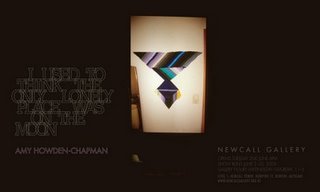John Hurrell – 7 June, 2009
The Irish Empiricist philosopher George Berkeley (1685-1753) once argued that if something is not perceived it does not exist.
Auckland
Amy Howden-Chapman
I used to think the only lonely place was on the moon
3 June - 20 June 2009
Amy Howden-Chapman is well known as half of the Wellington based performance group Raised By Wolves. Here at Newcall where she has performed on an earlier occasion, she presents a number of items: a carousel of sequenced slides projected on one wall; another projector on the floor, lightless with the carousel rotating while covered with rumpled plastic; a narrow catalogue of four brief, but beautifully constructed, essays from different authors; and eight fabric paintings made of triangles of striped cotton, pinned in angular configurations on the walls. The latter dominate the room.
Howden-Chapman’s slide projection however catches your eye first. It shows the lush green vegetation of the Amazon rain forest, blurrily photographed from the river. One salient lengthy sequence shows a large tree falling and crashing through the dense undergrowth. There are no signs of millers.
The Irish Empiricist philosopher George Berkeley (1685-1753) once argued that if something is not perceived it does not exist. If a tree falls in an isolated forest it not only does not make a sound if there is no one around to hear it, but it doesn’t exist either. If it does exist, the reason is because God watches over the forest too, and He perceives it.
These two carousels seem to comment on Berkeley - as do the fabric constellations which look like kites or geometric birds in the sky. They seem to represent a spiritual dimension, an all pervading omnipresent power. There is also something slightly Native American about the motifs.
To construct these forms the various striped cotton triangles, diamonds and skinny parallelograms have been cut from bedspreads or tablecloths made up of stitched coloured bands, and as such are related to quilts such as those made by Amish and other religious communities in America. The pulsing bands in these sections when pinned up are mostly aligned horizontally, occasionally diagonally, and very rarely vertically.
When contrasting striped tones are alternated and not too harsh, the chroma glows softly and is reminiscent of sections of paintings like Rousseau’s The Sleeping Gypsy. However Howden-Chapman in her positioning of these linked (but never overlapping) snipped triangles is not precious about finish. The borders are left as cut, a little ragged with some loose threads not tidied up. Some of her geometric configurations look improvised on the spot, and others seem carefully preplanned. With these very portable works, the larger combinations tend to be symmetrical; smaller ones not.
In an included essay she herself has written, Howden-Chapman looks on grunge as “an attempt to protect the ability to feel in amongst a deluge of manipulation” and in a discussion about overhype, says this:
“Back in the nineties…people were ‘Friends of The Earth and conservationists. People were still chaining themselves to trees, and hugging without irony. The same impulses are still being played out now with a new language… attempts by governments to implement the ‘greening’ of the economy’ has come with ‘green washing’ the environmentalist values for profit. Cars that are just slightly more fuel efficient than regular cars are being advertised as having the ability ‘to protect your family and the earth.”
I think her idealism is reflected in the fabric wall paintings, art which Laura Preston in her essay compares to Tomma Abts’ practice - as being ‘uncertain documents’ that come from ‘an intuitive approach’. These works though, being of fabric, are closer to the art of seventies feminist ‘craft’ painters like Joyce Kozloff or Miriam Schapiro, and don’t seem so time-based in process as Abts. They are not like say, Dorothea Rockburne, where the procedures in thinking are laid out in detectable stages. They may be improvised to a degree, but unlike Abts the processes are not embedded in the final visual statement.
This exhibition works as an intriguing cohesive statement rather than as a collection of honed individual parts. With three excellent essays and one inflammatory interview in the catalogue (Anna Sanderson and Genevieve Michaels are included) it is a classy well articulated presentation about craft, changing taste, cynicism and eco-politics.
John Hurrell

 Two Rooms presents a program of residencies and projects
Two Rooms presents a program of residencies and projects Advertising in this column
Advertising in this column



This Discussion has 0 comments.
Comment
Participate
Register to Participate.
Sign in
Sign in to an existing account.